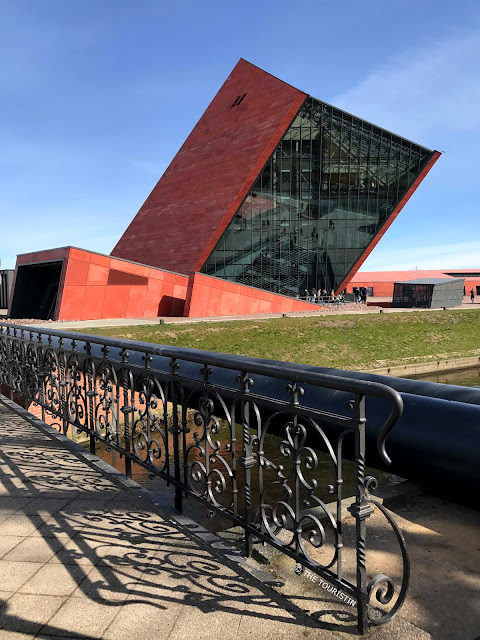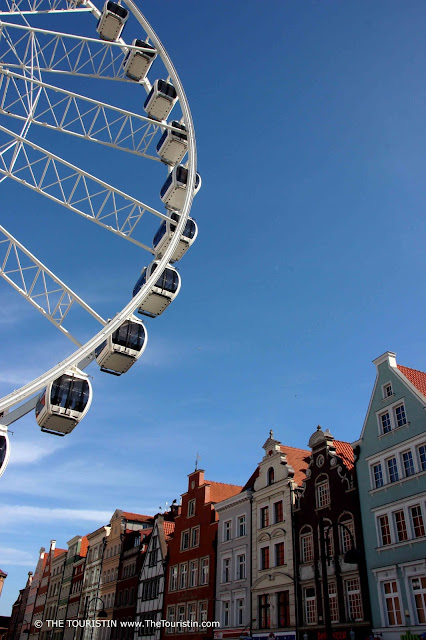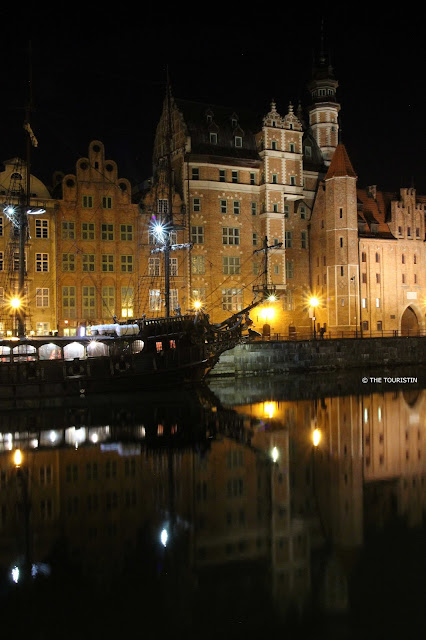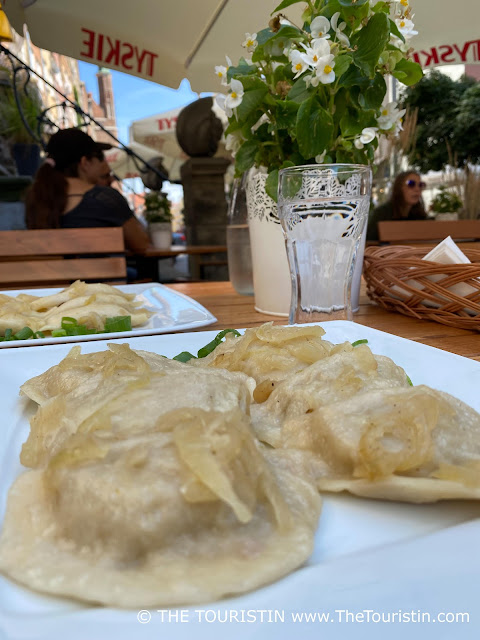A pastel-coloured old town and
a maritime river embankment, the city is certainly one of Poland’s treasures. The
Pomeranian town by the River Motlawa was first mentioned and founded in the 10th century. Gdańsk
has a seafaring tradition, the harbour is the largest in Poland and the Old
Town of Gdańsk is full of Hanseatic architecture. Over the course of its
thousand-year history Gdańsk was controlled by different nations, and it is a gripping
exercise when you look at different maps and slowly start to understand its
turbulent and surely strenuous history. The physicist Daniel Gabriel Fahrenheit,
as well as the philosopher Arthur Schopenhauer, were both born in Gdańsk. It is
here where World War 2 started on 1. September 1939, and where Lech
Walesa founded the Solidarity movement in the 1980s that brought the world
closer to the end of communism.
Gdańsk is a fascinating
place to visit and visitors come from all over the world to learn about
its history. It was severely damaged in WW2 and has been lovingly restored to its
former glory. The town is buzzing with excitement during the day. If you go for
a wander in the early morning or for a late night stroll, it happens that it
feels like walking through a fairy-tale. I'm happy to show you where to see, eat, think and sleep in Gdansk and Sopot.
Museum of the Second World
War in Gdańsk
This striking glass and
cement structure stands in an area of Gdańsk that was destroyed in WW2. It took
eight years of planning the Museum of the Second World War. There is an
impressive staircase that leads down to the entrance, one you can see mirrored in the windows. Visitors go down three levels to learn about
civilian life under Nazi Germany and Stalin’s Russia. This is a place that
explains how the rise of authoritarian regimes led to a war. Standing here, in
this beautiful city, on a sunny day in spring, it is so hard to comprehend that
the Germans invaded Poland on 1. September 1939 that started WW2 in which 60
million people were killed. The question that remains is whether we have
learned from WW2 or not.
Info Museum of the Second World
War. Władysława Bartoszewskiego 1, 80 – 862 Gdańsk. Hours: Mondays closed.
Tuesday 10am to 4pm. Wednesday to to Sunday 10am to 8pm. Latest admission: 5pm. Tickets: Free on
Tuesdays. Admissions adults 29 PLN. Buy tickets in advance.
 |
| Facade of Museum of the Second World War |
 |
| Museum of the Second World War |
Hala Targowa - Food Market in Gdańsk
There used to be Dominican
monastery here that was destroyed during the siege of Gdańsk in 1813 by
Russian-Prussian troops. The ruins were demolished decades later and in 1896 a beautiful Neo-Gothic style market
hall was built. Today
it houses the local food market of the Old Town. You can buy clothes on two
levels and outside they sell fresh fruit, nuts, herbs, spices and vegetables.
Remember the reason for travelling is to learn about different cultures. Visit
this place; it is always exciting to see what the locals buy. Take the time to
check out the basement of the market. Bilders discovered the oldest church of Gdańsk
during renovation works of the market hall. You even find the remains of
the foundation of the Dominican monastery. I love that about Europe; they
dig and often find some ruins that tell of times gone by.
Info Hala Targowa. Pl. Dominikanski 1, 80-884 Gdańsk.
Hours: Monday to Friday 8am to 6pm. Saturday 8am to 3pm. Closed Sunday.
Polish Dumplings - Eat Pierogi in Gdańsk
The culinary influences of French, Italians, Germans,
Armenians, Hungarians and Jews in Polish cooking are
obvious. The sea, forests, meadows, fields, rivers and lakes have always been and are to
this day main sources for chefs all over Poland. Sauerkraut, pickled gherkins,
marinated and dried mushrooms, groats and sour milk are just some staples used.
There must be a hundred ways to eat pierogi. A
vegetarian option is to eat the ones with sauerkraut and mushrooms. They are
traditionally eaten at Christmas in Poland but you find them on most menus
during the year. The dough is made from water and flour, and then rolled out
and cut into circles. The freshly prepared filling is placed onto circles,
which get then folded into half circles (same preparation as what you would do
when making fresh Italian ravioli). The pierogis are boiled for a few minutes
in salted water and served with butter and caramelized onions. While I eat my
portion of Pierogi I can clearly see the Pomeranian landscape I drove through
on my way up to Gdańsk, along forests, meadows, fields, rivers and lakes.
Info: I
went to Pierogarnia Mandu. Ul Kaprow 19D, 80-316 Gdańsk. Monday to Sunday 11am to 10pm.
Golden Gate and the Architecture on and around Dluga Street in Gdańsk
The Złota Brama (Golden
Gate) at the end of Ulica Długa (Long Street) built in the 16th century in
Renaissance style was once the main entrance to town. On top of the gate there
are eight statues that represent: Peace. Liberty. Wealth. Fame. Wisdom. Piety.
Justice. Harmony (Concord). There is a Latin inscription on the gate facing
this street that says: “Consent builds little republics, dissent ruins great
ones.” I can’t get this out of my head. Gdansk was almost completely destroyed
in WW2 and this street (as so many others) has been reconstructed after the war.
It is horrible and tragic what happened during the war, but with a focus on the
future, I am totally fascinated by how they rebuilt the whole town so
beautifully.
 |
| Facades on Long Street. Gdansk, Poland |
 |
| Green Gate between Motlawa and Long Street. Gdansk, Poland |
 |
| Facades on Long Street. Gdansk, Poland |
Climb the Tower of St Mary’s Church in Gdańsk
The foundation of this 105.5 metre long protestant
church was laid in 1343. Building works, to what is said to be one of the
largest red brick build churches in the world, finished 159 years later. The
church only became a catholic place of worship after the renovations that
followed the severe damages of WW2. If weather permits make your way up the 409
stairs of the tower of St Mary’s church. The view over the red rooftops and all
the way to the port is worth the climb. Most visitors are out of breath from
the exercise, and it is fun to see lots of reddened faces and
reactions after they get back down to the ground. In the church you might find
it worthwhile to have a look at the 15th century astronomical clock
and a Mother of Pearl decorated grotto as a shrine to the sea.
Info St Mary’s Church. Ul. Podkramarska 5, Gdańsk 80
– 834. Ticket: 6 zl. Hours: 1st October to 30th April: Monday to Saturday:
8.30am to 5pm. Sunday: 11am to 12pm and 1pm to 5pm. // 1st May to 30th
September: Monday to Saturday: 8.30am to 6.30pm. Sunday: 11am to 12pm and 1pm
to 5pm.
 |
| In the Shadow of St Mary's Church. Gdansk, Poland |
 |
| St Mary's Church. Gdansk, Poland |
|
| View from the Tower of St Mary's Church. Gdansk, Poland |
Visit the grave of Paweł
Adamowicz
In the summer of 2019, Gdańsk,
the city of freedom and solidarity, celebrated the 30th anniversary of the
first partially free elections in Poland. The former mayor of Gdańsk, Paweł
Adamowicz, could not celebrate with his town, he was stabbed during a charity
event in January 2019. Paweł Adamowicz was well-loved, he was the mayor of
Gdańsk for over twenty years.
As a homage to his life, ICORN
(International Cities of Refuge Network) established the Adamowicz Award. It
recognizes "all the ones who work with courage and integrity against
intolerance, radicalisation, hate-speech, oppression and xenophobia, and who promote
equal opportunities, social integration and fundamental rights." Visit his grave at St Mary's Church and pay
the former mayor a visit. St Mary's Church largest brick church in the world.
A
façade well-travelled - Dom Schlieffów
This
is the most amazing story. As often in life, the reality is stranger than fiction
and the whole story is almost a bit too bizarre to believe. This Gothic facade
of an old patrician house was built in 1520 in Gdansk. In 1822, Frederick
Wilhelm III of Prussia learned that it was to be demolished. After he decided
to buy the facade it was transported by ship to Berlin in Germany. Architect
Schinkel designed the whole property so that it would work together with the
new facade. Existing buildings were demolished. A new foundation was set. The
structure was rebuilt. Ornaments were added. Meanwhile, the people in Gdansk
filled that gaping hole with a building in a different style. In WW2, and
together with all atrocities, the Germans committed, also this building in Gdansk
was destroyed. In the 1970s, a new house was erected designed in line with the
original from 1520. The one in Berlin. In short. The original is now in Berlin
and the copy is at its original location. The reality, stranger than fiction.

Info: Dom
Schlieffów, Chlebnicka 14, Gdansk.
Take a Ride on Amber Sky in Gdańsk
Take a 15 minute long ride in one of the 36th
gondolas of the 50 metre high Amber Sky, a giant observation wheel on Granary
Island. The former warehouse district of Gdańsk, nearly completely destroyed in
WW2 was left untouched until recently, as an investor was found to rebuild the
area.
Info Amber Sky. Ul. Chmielna 6, Granary Island. Tickets: 37 zl. Hours Monday to Sunday 10am to 11pm.
 |
| View towards Amber Sky on Granary Island. Gdansk, Poland |
 |
| Amber Sky on Granary Island. Gdansk, Poland |
Gdańsk and its Seafaring Tradition
– The Crane and National Maritime Museum
Gdańsk has a seafaring
tradition. The brick Gothic architecture of the port city is typical for towns
around the Baltic and the North Sea. Stand here by the river Motlava and imagine
life on a ship with waves as high as a three storey houses and wind at gale
strength. To this day the port and shipyards are still economically important.
The crane, a double-timbered
wooden structure, erected as a hoist in 1363, was destroyed in 1442 by a fire
and rebuilt two years after that. 500 years later, in 1945, the wooden construction of
the crane burnt down (again) and the stone elements were severely damaged. What
you see today is the perfectly reconstructed version of the original structure.
Learn all about Gdańsk’s maritime heritage at the National Maritime Museum.
Info National Maritime Museum Gdańsk.
Olowianka 9-13, 80751 Gdańsk. Tickets: 20 PLN. Hours: Monday to Tuesday and Thursday to Sunday 11am to 6pm. Wednesday 1pm to 6pm.
 |
| Motlawa. Gdansk, Poland |
 |
| Motlawa. Gdansk, Poland |
Searching for Amber on Mariacka Street in Gdańsk
This cobble stoned street between St Mary’s Gate and
St Mary’s Church is hundreds of years old. There are many shops selling amber and
a library. Stone perrons lead to elegant patios; the wooden entrance doors of
respectable Patrician houses are sturdy. The gargoyles that resemble small
dragons cover the rain gutters between properties and create a somewhat mystic air.
Go early to have the street for yourself, wait, this is not true. You will
certainly meet several cats.
 |
| Cat on Mariacka Street. Gdansk, Poland |
Drink Third Wave Coffee and Eat Bagels in Gdańsk – Drukarnia Café
In this former printing house you get a cute
interior, a friendly and warm welcome, bagels for breakfast and beans from
roasters such as Coffee Collective from Copenhagen in Denmark, Fjord in Berlin
and Kofi from Warszawa, Poland. What is not to like? Where else would you want
to eat bagels but in Poland where bagels were brought to life in the 14th
century. A bagel is made from flour, salt, water, yeast and malt. I have never
been a big fan of them but since it is the primary choice for breakfast at Drukarnia,
I ordered one, not knowing that it is a Polish thing. It was so delicious that
I ordered a second helping. This café converted me to a bagel fan. As always,
others claim bagels to have been their idea (Germans and Austrians), never
mind, one thing is for sure, it is going to keep historians occupied for the
next coming centuries.
Info Drukarnia Café. Mariacka 36. Hours: Monday, Tuesday, Wednesday, Thursday, Sunday: 9am to 9pm. Friday and Saturday 9am to 10pm.
Go for a beach walk in Sopot
The maritime resort on the
Baltic Sea is only a short drive from Gdańsk and busy on sunny days. It is
bicycle galore, crazy dogs jumping around you, and people holding their faces
towards the sun. In spring and summer and after months of probably too overcast
and icy cold weather the crowds are desperate to refill their vitamin D levels.
There is beautiful architecture, most built around 1900, all lovingly restored.
You can walk on the beach with its white sand for hours and take a wander along
the longest wooden pier in Europe. Use the train to Kolobrzeg to commute the 12 kilometres from Gdansk to Sopot. Finding a park for your car is a challenge on a sunny day.
 |
| Beach walk - Sopot, Poland |
 |
| The longest pier in Europe - Sopot, Poland |
Puro - Go to bed in Gdańsk
Every day comes to an end at one point. I booked a
room at a hotel in the best location of town, conveniently located a one minute
walk from the Old Town on Granary Island. The view over the Motlawa and the Old
Town of Gdańsk is picture postcard perfect, I was so lucky to stay in a room
facing towards it. It is a fun and relaxing place to stay. The staffs at
check-in were welcoming and friendly to chat to. The reception area is open-plan
with a direct view over the restaurant and the bar area with its books and
magazines and all the way up the eight levels of the hotel. On one night I had
dinner at their restaurant, and I had a good time. The Wi-Fi is password
protected. Matching the fabulous Skandy ambience of the hotel the hotel itself
is immaculately clean. There are enough hangers in the wardrobe, plenty of
electrical sockets, the hairdryer is powerful and the sleep quality is great. Highly
recommended. Puro proves that you don’t have to be rich to travel in style.
Info Puro Gdańsk. Stągiewna 26, 80-750 Gdańsk. Rooms go
for plus/minus EUR 130.
 |
| Bar Puro Gdansk |
 |
| Bathroom in room Puro Gdansk |
 |
| Reception area Puro Gdansk |
 |
| Restaurant Ink Puro Gdansk |
 |
| Reception area Puro Gdansk |
How to get to Gdansk
Take the car. Gdansk is easy to reach by car. Most hotels offer parking.
From Berlin with love
Udated July 2023.

































